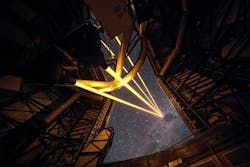IMAGE: ESO’s Paranal Observatory in Chile marked the brilliant first light for the four powerful lasers that form a crucial part of the adaptive optics systems on ESO’s Very Large Telescope. These are the most powerful laser guide stars ever used for astronomy and mark the first use of multiple laser guide stars at ESO. This image shows the four beams emerging from the new laser system on Unit Telescope 4 of the VLT. (Image credit: ESO/F. Kamphues)
On 26 April 2016, the European Southern Observatory's (ESO's) Paranal Observatory in Chile hosted an event to mark the first light for the four powerful lasers that form a crucial part of the adaptive optics systems on ESO’s Very Large Telescope (VLT). Attendees were treated to a spectacular display of cutting-edge fiber laser technology against the majestic skies of Paranal. ESO staff were present for the event, along with senior representatives of the companies that have manufactured the different components of the new system.
RELATED ARTICLE: Toptica SodiumStar laser installed at ESO's VLT in Chile
The Four Laser Guide Star Facility (4LGSF) shines four 22 W laser beams into the sky to create artificial guide stars by making sodium atoms in the upper atmosphere glow so that they look just like real stars. The artificial stars allow the adaptive optics systems to compensate for the blurring caused by the Earth's atmosphere and so that the telescope can create sharp images. Using more than one laser allows the turbulence in the atmosphere to be mapped in far greater detail to significantly improve the image quality over a larger field of view.
The ESO says its Four Laser Guide Star Facility (4LGSF) is an example of how ESO enables European industry to lead complex research and development projects, and that the fiber laser used by the 4LGSF is one of the most successful transfers of ESO technology to industry.
TOPTICA, the German main contractor, was responsible for the laser system and provided the oscillator, the frequency doubler, and the system control software. Wilhelm Kaenders, president of TOPTICA, said, "TOPTICA has enjoyed the collaboration with ESO tremendously. It is not only the personal thrill of being engaged with astronomy, an old passion, again, and working with very clever ESO technologists; it is also the inspiration that we have received for our own commercial product development."
MPB Communications of Canada provided the fiber laser pumps and Raman amplifiers, which are based on an ESO licensed patent. Jane Bachynski, president of MPBC, said, "MPBC is proud to have worked with ESO in the development of Raman fibre amplifiers to much higher powers, allowing MPBC to bring this technology to the stars. This event marks the culmination of many years of hard work on behalf of all involved."
TNO in the Netherlands manufactured the optical tube assemblies, which expand the laser beams and direct them into the sky. Paul de Krom, CEO of TNO, said, "TNO valued the cooperative working environment during the development of the optical tube assemblies and looks forward to the opportunity to work with ESO and the other partners in the 4LGSF project in the future."
The 4LGSF is part of the Adaptive Optics Facility on Unit Telescope 4 of the VLT, designed specifically to provide the adaptive optics systems GALACSI/MUSE and GRAAL/HAWK-I with four sodium laser guide stars. With this new facility, Paranal Observatory continues to have the most advanced and the largest number of adaptive optics systems in operation today.
The 4LGSF lasers were developed by ESO with industry and have already been procured, among others, by the Keck Observatory (which contributed to the industrial laser development cost along with the European Commission) and the Subaru Telescope. In the future these industrial lasers will also feature on the telescopes at the Gemini Observatory and will be the preferred choice for several other observatories and extremely large telescope projects. In addition, the new techniques developed for the 4LGSF pave the way for the adaptive optics system of the European Extremely Large Telescope (E-ELT), which the ESO says is the world's biggest eye on the sky.
SOURCE: ESO; http://www.eso.org/public/news/eso1613/
